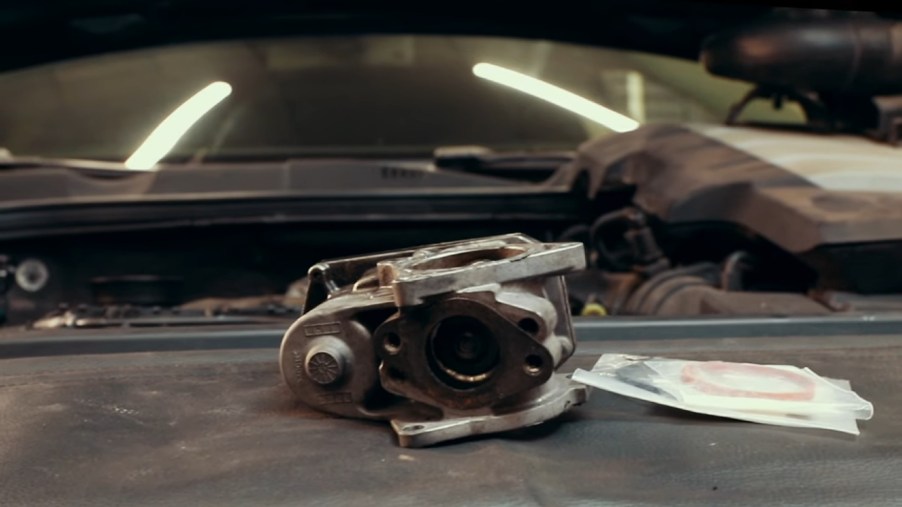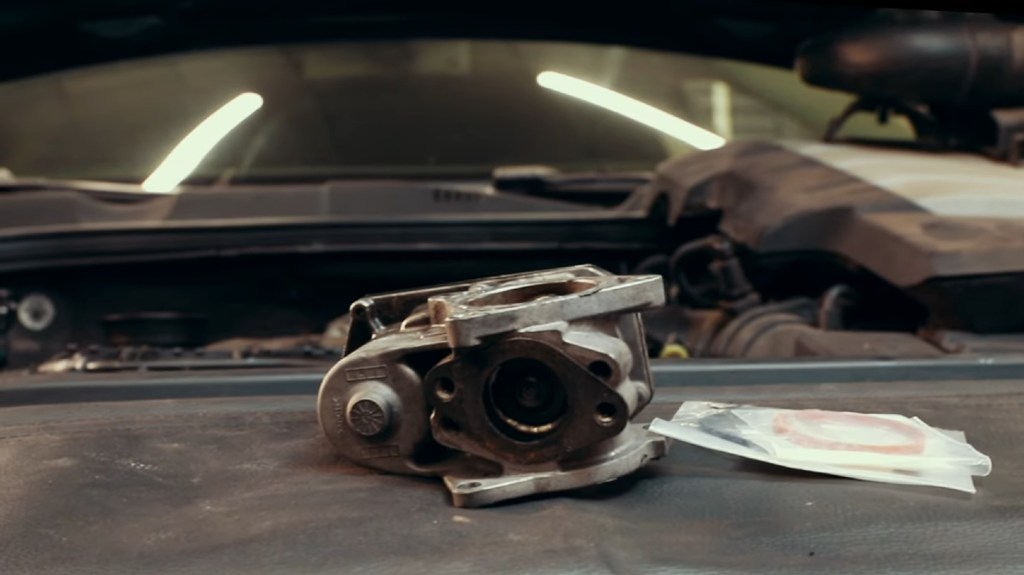
Engine Knocking and Weak? The EGR Valve Might Need Cleaning
Cleanliness doesn’t often come up in wrenching discussions, but regularly washing your car is genuine maintenance. However, cars’ exteriors and interiors aren’t the only things that need to be regularly cleaned. While you shouldn’t power-wash your engine, if you let grime build-up, it can lead to all sorts of problems. That list of problems includes part failures, which can eventually lead to engine damage—or worse. And one of those parts is the EGR valve.
What does an EGR valve do?

Internal combustion engines produce a variety of exhaust gases, many of which are harmful to humans and the environment. That’s why cars have catalytic converters, to convert some of these gases to less harmful variants. However, even the best ‘cat’ can only do so much, especially against NOx (nitrogen oxide) emissions. Luckily, it doesn’t shoulder clean-up duties alone.
Internal combustion, whether you’re talking gasoline or diesel, involves fuel reacting with incoming air. More specifically, with the oxygen (O2) in the air. However, air is only about 20% O2; apart from a few trace gases, nitrogen (N2) makes up the rest. Normally, N2 is inert. But when it’s heated to over 25000° F, CarBibles explains, it reacts with O2 to form NOx, the key ingredient in smog. And that’s a particular problem for diesel engines because of how they operate.
Diesel engines have exhaust fluid to help mitigate NOx and other harmful emissions. But they, like gasoline-powered engines, also have exhaust gas recirculation systems. And it’s here where the EGR valve comes into play.
Generally speaking, after they’re generated during combustion, exhaust gases leave via the exhaust headers/manifold. And when your engine is cold, that’s precisely what happens. But after it warms up sufficiently as you’re going down the road, the EGR valve begins to open. When that happens, some of the exhaust gases go back to the intake manifold. This is the ‘recirculation’ part of ‘exhaust gas recirculation.’
Mixing exhaust gases with incoming air dilutes the proportion of O2. This slows the combustion process slightly, which also lowers the temperature inside the combustion chamber. Therefore, NOx production either stops or slows down considerably. And when your engine slows down, the EGR valve slowly closes, because less incoming air means lower exhaust gas recirculation needs.
A clogged or failing EGR valve has more symptoms than just engine weakness
CO2 and NOx are inevitable by-products of internal combustion, but so is carbon, aka soot. And it builds up in places like the fuel injectors, throttle bodies, and the EGR valve. A small amount isn’t necessarily the end of the world, but it never stays small.
Over time, soot clogs your EGR valve and makes it fail, throwing a wrench into the entire system. That causes engine problems, up to and including fires. Your engine can technically run without a fully functioning exhaust gas recirculation system, but it won’t run well or cleanly. If you need proof, know that a disabled EGR system is part of the diesel truck rolling coal recipe.
The good news is that a failing EGR valve often makes itself known through several symptoms. One is an illuminated Check Engine Light, though other problems also cause this. A rough idle is a clearer symptom, though. It’s caused either by a vacuum leak from an open valve or excessive emissions from a stuck one. The former causes incomplete combustion, while the latter screws with engine timing, CarBibles explains, but the result is the same. And in extreme cases, your engine may stall entirely.
Because EGR valve failures affect the air-fuel mixture, you may also notice that your engine isn’t as strong as it was before. And because it has to burn more fuel to make power, your fuel economy will drop. Excessive fuel usage often leads to a strong odor, too. Plus, with your exhaust gas recirculation system out of whack, your car will emit more emissions. So, don’t be surprised if it fails an emissions test.
How do you clean out your EGR valve?
The good news is that, if you catch it in time, you can clean the carbon out of your EGR valve. Many automakers recommend doing so at least every 50,000 miles, Autoblog reports. And you don’t necessarily have to go to a mechanic to clean it out.
First, locate the EGR valve, if your car has one (my 500 Abarth’s EGR system, for example, eliminates the need for one). It’s usually between the intake and exhaust manifolds. Older cars have vacuum-operated valves that look like metal disks that may or may not have sensors attached. The latest versions, though, are electronically-operated, and are more block- or cylinder-shaped, CarBibles says. When in doubt, check your owner’s manual.
Once you’ve located the EGR valve, make sure your engine is off and cool. And for safety, disconnect the battery. Then, carefully remove all electrical connectors and vacuum hoses from the EGR valve, and note any signs of damage. You may also have to remove some metal pipes connecting it to the exhaust/intake manifolds. Once these are all removed, you can take the EGR valve with its gasket out.
With gloves and safety glasses on, remove the gasket and spray the valve with an appropriate cleaner. There are EGR valve cleaning solutions available, though carb cleaner works in a pinch, CarBibles says. And you can also use it to clean the intake manifold and metal connecting pipes. A soft brush also helps remove stubborn carbon deposits. But don’t get any cleaning solution on the electrical connectors, rubber hoses or gaskets, or plastic parts.
Once the valve is clean, reinstall and reconnect everything. With luck, your CEL should turn off and your engine will be back to normal.
Should you clean the valve or just replace it?
Although carbon build-up clogs EGR valves, they can fail in other ways. Gaskets can break, hoses can snap, and electronic components can simply stop working. EGR valves don’t have a set lifespan, Autoblog says. As such, it’s tough to say when you should replace yours. But if you clean it out and your car’s symptoms don’t improve, it might be time to replace it.
EGR valves aren’t terribly expensive, though the exact cost depends on the make and model. The one for my old NB Miata costs about $135, for example. But one for, say, a used Aston Martin V8 Vantage might cost about twice as much.
So, while replacing the valve might be easy, cleaning it out will save your engine and some cash.
Follow more updates from MotorBiscuit on our Facebook page.


